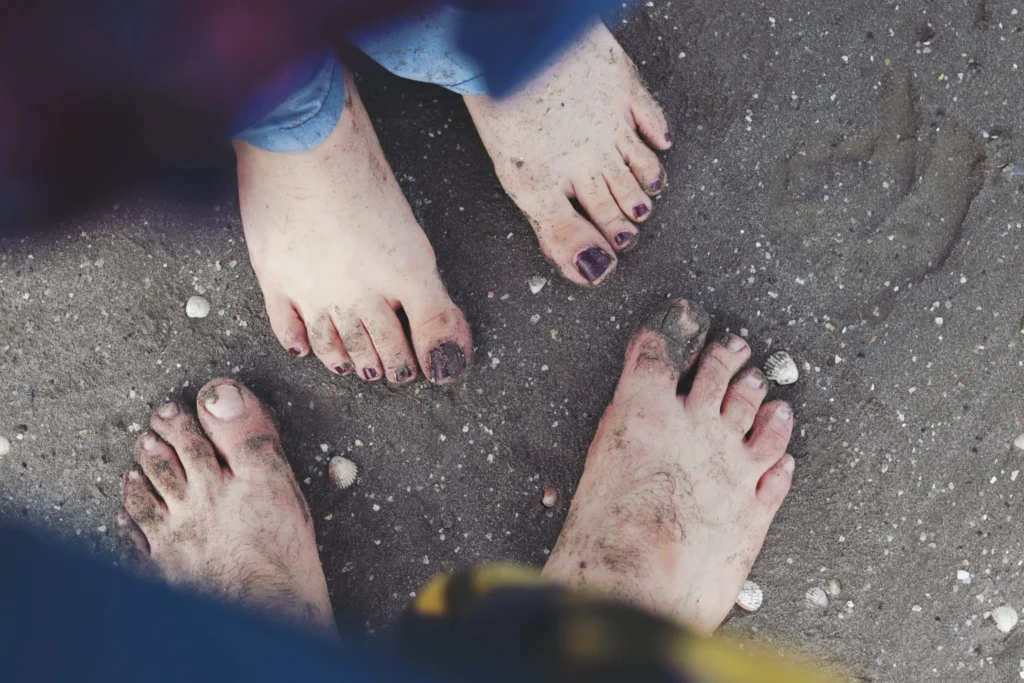There is nothing more worrying than finding a new lump developing on your foot, and it’s even worse when that lump becomes painful and stops you from living your daily life! Verrucas and corns are the most commonly treated foot complications at podiatry clinics around the world. Sadly, by the time a patient gets to see a podiatrist, they have usually misdiagnosed their condition themselves with the power of D.R Google and, of course, attempted self-treatment at home, often making the situation worse!
What is a corn?
A corn usually appears in a spherical bump, which is raised, usually with a layer of dry skin over the top, giving a yellow appearance. They develop due to increased pressure and friction and are most commonly found on the ball of the foot, joints of tiny toes and in-between toes. Thickened skin is formed to protect your foot from any pressure or friction – the thickened skin becomes compacted and dried, creating hard skin (like a callus).
So, how do you treat a corn? By all means possible, avoid corn plasters; they contain acid in them to break down this hard skin layer. However, they can cause more damage to the corn area and, as such, attract ulcerations. Instead, try devices to offload the pressure from the site. It would also be beneficial to make an appointment with a podiatrist. They can use a scalpel to remove the corn in a process known as enucleation.
What is a verruca?
A verruca is described as a non-cancerous tumour-like substance formed due to the Human papilloma virus. A verruca is remarkably similar in appearance to a corn. They, too, develop into a hard callus lump, although there are a few subtle differences. Usually, you will see tiny black dots forming in the middle of a verruca, and these are the capillaries bleeding as the virus initiates a hard lump. They can appear anywhere on the foot, but the most commonplace is the sole. Unfortunately, they are contagious, so precautions need to be taken to prevent spreading.
Wondering how to treat a verruca? Well, verrucas are known to disappear on their own over time, so if they aren’t bothering you, it may be wise to leave them alone. However, if you do want to treat them, you can try these treatment options:
- Falkner’s needling (verruca needling) – This method of verruca treatment works by repeatedly pricking the site of the verruca. This penetrates the virus into the healthy fatty tissue underneath the verruca and, in doing so, exposes the virus to the body’s immune system. This then activates the body’s natural healing system, allowing your immune system to recognise, target and destroy the virus. This is performed under a local anaesthetic and so isn’t painful at all.
- Cryotherapy – Using cryotherapy to treat verrucae is a painful method of treatment. It aims to lower the temperature of the verruca to -196°C using liquid nitrogen and, in doing so, destroy the verruca by damaging the skin containing the virus. Due to its destructive nature, this method of treatment is particularly good at treating mosaic warts (a cluster of verrucas all in the same position).
- Verrutop – Verrutop is a new form of topical verruca treatment. It is a combination of 3 organic acids, lactic, acetic, and oxalic. When it is applied to a verruca, it makes the proteins of the verruca become dry and dehydrated, causing the verruca to break down.
- Swift verruca therapy – Swift verruca therapy uses highly controlled and targeted microwave energy using a hand-held probe. It sends this microwave energy into the verruca, creating heat in the water molecules of the skin, similarly to verruca needling, activating the immune response of the body to destroy the infected cells. It leaves the healthy surrounding skin of the verruca undamaged.
What are the differences between a verruca and a corn?
On taking a closer look, you will notice that a corn tends to have a conical, circular shadow underneath the hard skin that isn’t often seen in a verruca. Furthermore, verrucas have a less even colour tone, whereas a corn tends to be more unified in colour. You can also partake in what is known as a squeeze test; direct pressure on a corn will cause slight pain, whereas this is very rare in a verruca as they are more uncomfortable than anything else. These are all good options to tell the difference between a corn and a verruca; however, the most beneficial would be to visit a podiatrist for immediate results.
Frequently Asked Questions
Can verrucas and corns develop on other body parts besides the feet?
Verrucas and corns are most commonly found on the feet, however, they can potentially affect other areas of the body, such as the knees and hands. When verrucas appear on other body parts, they are called warts instead.
Can verrucas and corns be related to an underlying medical condition?
If you are experiencing reoccurring verrucas and corns, it could be a sign of an underlying medical condition, e.g. an immune system disorder, however, it is best to consult with your podiatrist or book an appointment with us to determine the cause.
Can verrucae and corns be transmitted through contact with contaminated surfaces?
Corns cannot be transmitted through contact from one person to another. Conversely, verrucas are endemic and cannot be avoided easily. Due to this, there is no need to worry about going swimming if you have a verruca, as the virus is most likely already at the swimming baths before we get there. It is important to remember that you are more likely to be contaminated when your skin is wet or damaged, and it can take a couple of months after infection before the verruca appears.
Can verrucas and corns recur after successful treatment?
Corns can recur, especially if the underlying cause is not appropriately treated. Hence, seeking a podiatrist’s advice and treatment is essential to prevent these reoccurrences. When a verruca is successfully treated, then it is gone. However, obviously, it is still possible to get other verrucas.
Do children have to get treatment if they have a verruca?
Unless the verruca is painful, we tend to leave them alone, as our bodies immune system eliminates them. Just like chicken pox, we often gain immunity against the virus. Since a virus causes verrucas, our body’s immune system is equipped to handle them. Although verrucas are clever at evading the immune system, it eventually reacts. Some of the most modern treatments try to initiate this immune system reaction.


